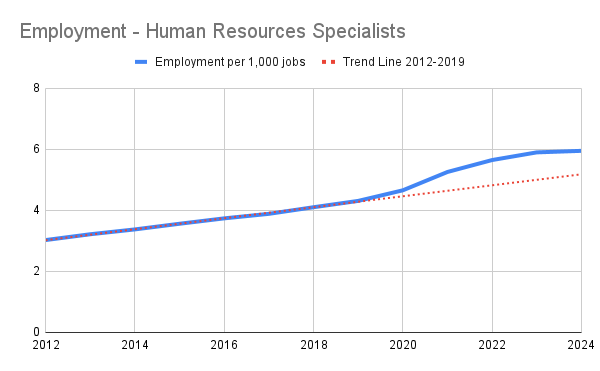Talent acquisition feels bad in 2025. Experienced TA leaders are “open to work”, recruiting teams are shrinking, and more broadly large parts of white-collar hiring seem frozen.
We in the TA profession have been living in this reality for over two years now.
Demand for talent acquisition professionals is facing pressure from three big changes: the hangover from COVID-era excesses, the general business environment’s renewed focus on efficiency, and the emerging structural shift driven by artificial intelligence (AI). Together, these forces are creating a perfect storm.
The COVID hangover
During the COVID-era, recruiters were in such high demand that there were more jobs available on LinkedIn for recruiters in tech than there were for software engineers.
Sound too good to be true? It was.
The US Bureau of Labor Statistics (BLS) groups talent acquisition professionals in their Human Resource Specialists category. The category includes other jobs in HR too, but it’s the closest proxy that we have for employment in talent acquisition employment, especially because there are separate categories for HR Managers, Training & Development, and Compensation & Benefits employment.
The BLS began tracking HR Specialists in 2012. Until 2019, the profession grew steadily and predictably as the economy grew and the labor market tightened. That steady rate of growth is the red dotted line in the chart below.
In the era of the Great Resignation from 2020 to 2023, the ranks of Human Resource Specialists exploded by over 248,000 people. That point where the blue line diverges from the red and starts going up? That’s a lot more recruiters entering the profession in those years.

This far outpaced overall workforce growth – in 2020, 466 out of every 100,000 workers was an HR Specialist. By 2023, that number had grown to 590.
That was unsustainable, and in 2024 it slowed to a crawl, growing more slowly than it has in any year since the BLS started tracking the category.
Big numbers tend to regress to the mean, and right now we are way above the historical trendline for employment in talent acquisition.
The “year of efficiency”
Meta CEO Mark Zuckerberg’s “year of efficiency” – and the company’s financial results – caught the attention of CEOs everywhere, and two years later companies in all industries continue to reduce headcount and slow hiring, leading to fears of a “frozen” labor market and decreased demand for recruiters.
This behavior echoes recent economic downturns, such as the dot-com crash in the early 2000s and the Great Recession in 2008. The big difference this time is that we are not in a recession – corporate profits remain robust. In the third quarter of 2024, U.S. corporate profits reached $3.1 trillion, a huge increase from $2.2 trillion in 2019.
The US economy has been resilient so far this year, even with all of the tariff chaos, but what will happen when we do slide into the next recession? We can’t be sure, but it’s likely that further belt-tightening will further contract the talent acquisition profession. Or possibly all the current efficiency-chasing could mean that companies are running lean, and have little room for further cuts.
AI: The elephant in the room
Contrary to fears of AI replacing recruiters entirely, the reality is more nuanced. Recruiters who leverage AI tools for tasks like sourcing, screening, and scheduling are becoming significantly more efficient than those who don’t. As AI technologies continue to advance and agentic AI becomes more widely used, this efficiency gap will widen.
This is part of a broader shift affecting white-collar workers. AI is beginning to impact knowledge-based roles in a way that is eerily similar to how automation affected manufacturing jobs over the last few decades. Economist David Autor has written that AI has the potential to either commodify expertise by automating complex tasks or enhance it by complementing human skills, and that a lot depends on the intent with which it is designed.
I don’t believe that AI will replace the recruiting function completely. But as AI tools become more prevalent, the demand for traditional recruiting roles may decline, as the TA professionals that embrace the new technologies outperform those who don’t adapt.
Gradually, then suddenly
While the cyclical pressures are temporary, the structural changes driven by AI are already beginning to reshape the talent acquisition profession. For all the hype, these changes have been hard to see so far, but big changes sometimes happen gradually, then suddenly. AI adoption is widespread in society, and it’s only a matter of time before that impacts the way we work.
After economic downturns, companies have historically rebuilt their recruiting teams. However, with AI enabling smaller teams to handle larger workloads efficiently, organizations simply won’t need to return to previous staffing levels.
